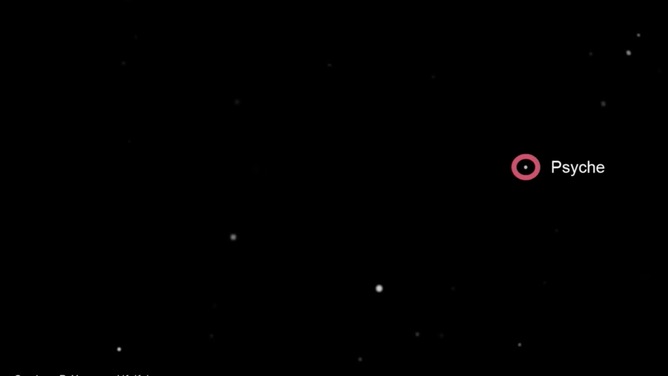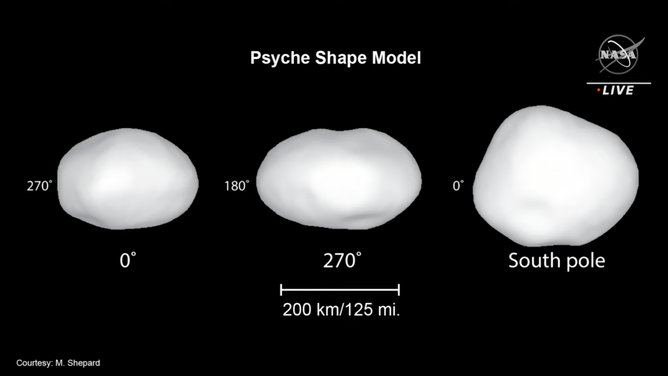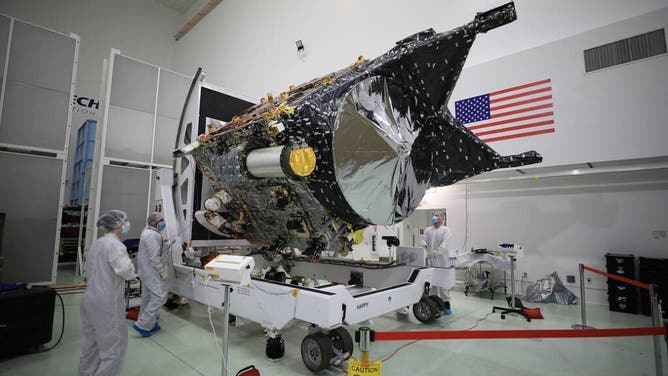NASA to visit metallic asteroid Psyche in search of clues about how planets form
So metal -- Scientists believe Psyche is a metal-rich asteroid because of its density and the light reflected by the asteroid. NASA spacecraft will begin to send back the first images of Psyche in 2029.
Psyche: NASA's mission to a metallic world
SpaceX will launch NASA's Psyche spacecraft to a metallic asteroid by the same name later this year.
A NASA mission launching in October will study the asteroid Psyche, believed to contain precious metals and clues to how planets form, but it won't make anyone rich on Earth, says Psyche's principal Investigator Lindy Elkins-Tanton.
Even if NASA or private space companies could haul back part of Psyche, it likely contains so much metal it would flood the metal markets, and it "would literally be worth nothing," said Elkins-Tanton with Arizona State University.
However, much of what scientists know about Psyche could be wrong. Right now, the best images of Psyche, three times farther from Earth than Mars, look like a pinpoint in the night sky.

Asteroid Psyche as seen from a ground-based telescope.
(NASA)
"Probably everything I just told you is going to be wrong," Elkins-Tanton said after being asked what color Psyche's surface might be.
Psyche was among the first asteroids discovered. Its official name, Psyche 16, is because it was the 16th asteroid discovered, found via telescope in 1852.
Scientists believe Psyche is a metal-rich asteroid because of its density and the light it reflects. It's located in the main asteroid belt between Mars and Jupiter.
"It's a very dense asteroid, currently the densest known asteroid, and because of the way that light and radar reflect off it, and we compare that reflected light spectrum to meteorites that have fallen to Earth, and that helps us know that it's largely made of metal," Elkins-Tanton said.
Scientists believe Psyche may contain leftovers from a rocky planet's core. The NASA mission will survey the metallic asteroid to determine how Earth's core and other terrestrial planets formed.
NASA plans to launch the spacecraft named after its destination on a SpaceX Falcon Heavy rocket from Kennedy Space Center in Florida. The exact launch time and date could change; a 21-day launch window opens in October with opportunities once a day. The first launch attempt could be at 10:38 a.m. EDT on Oct. 5.

Psyche shape models. A NASA spacecraft will provide the first close-up views of the asteroid in 2029.
More than 2,000 people have contributed to the $1.2 billion mission since its early stages in 2011. Initially planned to launch in late 2022, Psyche's liftoff was delayed to 2023.
More than a decade after the planning began, the team will have more waiting. The spacecraft won't come into view of Psyche until 2029, but another demonstration mission along for the trip will take advantage of the long ride.
The Deep Space Optical Communication technology demonstration mission is embedded in the spacecraft and will test communications a thousand times beyond the Moon using laser beams.
"This huge increase in distance brings with it new challenges and difficulties, and the DSOC project has developed technologies to overcome these challenges and to demonstrate a ten times augmentation of traditional telecom data rates that we get from Mars today," said DSOC Project technologist Abi Biswas, with NASA's Jet Propulsion Laboratory in California.
HOW NASA IS WORKING TO PROTECT EARTH FROM AN ASTEROID STRIKE
Mission timeline

NASA’s Psyche spacecraft is shown in a clean room on Dec. 8, 2022, at Astrotech Space Operations Facility near the agency’s Kennedy Space Center in Florida. (Image: NASA)
The first 100 days after launch will be busy preparing Psyche for its journey. Currently stowed like an accordion for launch, Psyche's solar arrays will unfold in space, and then the spacecraft instruments and functions will be tested.
The spacecraft is equipped with a suite of instruments and cameras to study the metal world of Psyche, including a multispectral imager to provide high-resolution images, a gamma-ray and neutron spectrometer to map the asteroid's composition and a magnetometer to measure the magnetic field of Psyche. The spacecraft will also use radio science to measure its gravity field, helping to determine the interior structure of Psyche.
The DSOC technology demonstration will begin on day 16 of spaceflight testing communications with light instead of radio waves.
SPACEX DRAGON SPACECRAFT SPOTTED ZOOMING BACK TO EARTH WITH CREW-6 ASTRONAUTS ABOARD
In about two years, Psyche will fly by Mars for a gravity assist and slingshot the spacecraft toward the asteroid.
By summer 2029, the spacecraft will begin seeing its target and navigating toward Psyche. These will be the closest images of the asteroid, yet currently, the closest images by ground-based telescopes show a faint dot in the sky.
Elkins-Tanton said she's been dreaming about what Psyche will look like when the spacecraft gets those first images. Even though it's mostly metallic, it likely won't be a shining jewel in space.
"It's been hanging out in space, getting solar, wind, hitting it for a really, really long time," she said. "So the surfaces are not likely to be shiny, and there's really only going to be one metal on the surface."
The spacecraft will orbit Psyche for 26 months, with each orbit zooming closer in altitude. At the lowest point, the spacecraft will be about 40 miles above the asteroid.
While the wait for a close-up of Psyche has been long, when the spacecraft arrives, images will be available for the public to view in near real-time. NASA will upload images taken by the spacecraft within 30 seconds after the space agency receives them.
